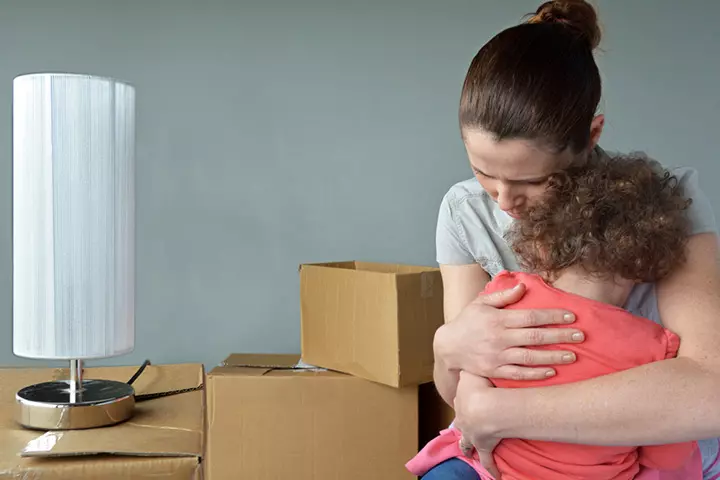
Image: Shutterstock
Shifting houses can be exciting and exhausting at the same time. When you are shifting with your entire family, the logistics and sheer amount of work involved can be overwhelming. The adults in charge will definitely go through worry and stress during the whole process. But we often don’t think much of how the change of home might affect our young ones. One of the common effects seen in children, in the weeks after shifting homes is the loss of normal sleep habits. This holds true even for babies and toddlers.
When children struggle with inconsistent sleep patterns, it can affect their overall health and development (1). It is essential to understand why this happens and what you can do about it, as not addressing the issue can cause a lot of later complications. Read on to find out how you can better handle your child’s sleep issues post shifting:
1. Why Moving Homes Can Affect Your Child

Image: Shutterstock
For adults, moving can take a toll primarily because of the logistics involved and the physical act of moving things itself. Packing items, ensuring that they’re safely moved, and the finances that come with it can all contribute to a lot of stress. It’s easy to assume that children don’t have as much on their hands, but the truth is that moving houses can have a stressful impact on them as well. Babies and toddlers alike find solace and comfort in predictable routines and familiar environments. Suddenly making them stay in a different house can make them anxious. Their routines may change, the people they used to interact with (neighbors) are different, and the house looks different. Such changes may be overwhelming to children who are sensitive or slower to adapt. It will be a while before they fully get used to the new place and until then, chances are that they will face discomfort from unfamiliarity.
One of the most evident changes that you notice after you’ve moved out of your house may be disrupted sleeping patterns in your child.
2. Signs That Your Child Is Being Affected

Image: Shutterstock
Although your child’s sleeping patterns are the most affected, there may be other indicators that your child is also having a tough time adjusting. You may notice the following things:
- They seem to be clingy and tagging along with you everywhere you go, even if it is from one room to another.
- They might show signs of disinterest in activities and loss of appetite.
- They seem to have lost their appetites and sometimes complain of aches and pains in their stomachs.
- They display signs of anxiousness such as fidgeting, shaking their legs, fiddling with their hair.
- They tend to show excessive aggressive behaviors or extreme shyness.
3. What You Can Do To Help Your Child

Image: Shutterstock
Understandably, you are worried about your child’s sleeping habits (or lack thereof), but all hope is not lost! Here’s what you can do to help your child:
4. Talk To Them

Image: Shutterstock
Is your child of the age where they can verbally communicate and understand things? If yes, then speak with your child. Tell them that you will be moving (or already have) to a new home, and just like the old home, this one too is a safe space. And if they allay their concerns to you, give it a patient listen. Let them express all their concerns and fears open-heartedly, and then address them in a gentle way. Let them know that change is inevitable, but that’s what makes life exciting!
5. Show Them Around

Image: Shutterstock
Let them see for themselves what the house looks like, as well as the surroundings. Your child may miss their old neighborhood friends, which is normal, but make them understand that they can keep in touch with them and make new friends too. Guide their attention to the things which are better in the new house. The new locality may have a park or an ice cream shop nearby, so show them these places to get them excited. Once they start seeing the good things of the new place they would warm up better and faster.
6. Get Them Involved In Setting Up

Image: Shutterstock
Packing isn’t easy, and you could do it with some help! Get your child to help around with some packing. Keep them away from fragile items, but they could help with their stuff such as toys and books. This gives them a sense of purpose, and they’ll understand better what’s happening. When your kids get to decorate and place the items themselves, the familiarity with the new place would kick start faster. The new home won’t keep feeling like a totally alien place and a sense of belonging will develop.
7. Create A Bedtime Routine

Image: Shutterstock
The previous points were essential to help them come to terms with their new house, but once that is out of the way, you’ll have to focus on their sleeping patterns. Create a good bedtime routine for them and make sure they stick to it. You may get a lot of protests initially, but be firm. Sleeping patterns, like other habits, are not formed in a day, and take repetition to set in. It’s okay to be a little lenient if they have nightmares, but even when that happens, spend some time with them and then, when they’ve calmed down, send them back to their rooms. This would make them self-sufficient in maintaining their own sleep habits in the long run
Make sure the new bedroom is well-ventilated and painted in calming colors. The bedroom is meant for sleeping, so don’t permit your child to watch television or play games in their bedroom. Limit screen time. Make sure your child does not use any gadgets at least two hours before bedtime. And to make sure that they don’t lose sleep too early in the morning, ensure that the room remains dark in the morning. Darker curtains would definitely help in this scenario to maintain the darkness in the room
It will require time and patience before your child gets used to the new home, which means it will take time for their sleeping patterns to get back to normal too. Try the above tips, and you should be able to see a difference in a few weeks. However, if there is no new improvement, then it’s best to consult a doctor to rule out any possibility of a sleep disorder. Do you have any suggestions that may help? Let us know in the comments below!
References
- Assessment And Treatment Of Common Pediatric Sleep Disorders
https://www.ncbi.nlm.nih.gov/pmc/articles/PMC2898839/
Community Experiences
Join the conversation and become a part of our nurturing community! Share your stories, experiences, and insights to connect with fellow parents.












